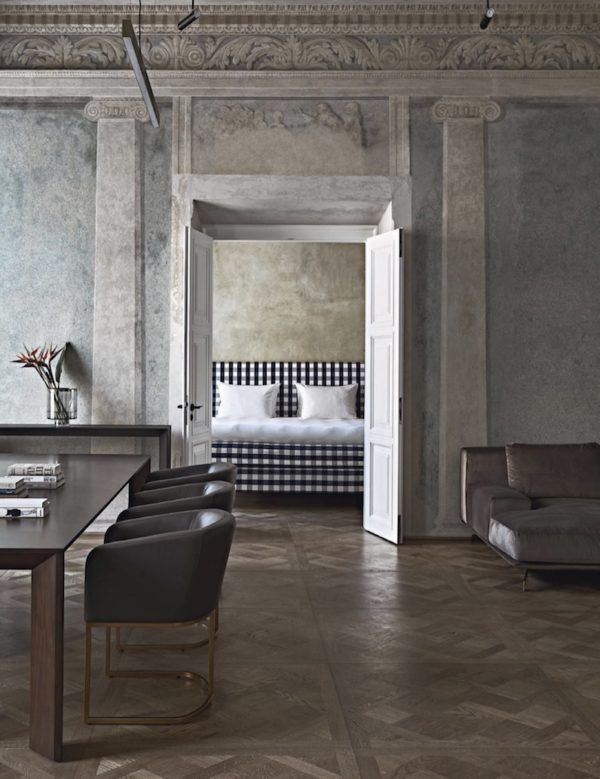Strong, clean and versatile, engineered timber is the ‘new concrete’. It’s the most technologically advanced form of construction for flooring in 100 years and one which mother nature holds the patent. Rigid, and durable, it insulates both heat and sound, can be prefabricated to high levels of quality and precision – and makes for quieter, calmer, cleaner building sites. Find out about this miracle floor vs reclaimed wood vs parquet. Plus options for fixing wooden flooring together. Also the best finishes. And why timber floors reduce stress, lower heart rates, calm children and improve wellness. We reveal some of the best brands to know, too. Read more, ‘Renovating 101: What to Know About The Four Most Popular Wood Floor Finishes.’
WHAT ARE THE DIFFERENCES BETWEEN SOLID WOOD, ENGINEERED AND LAMINATE FLOORING?
Engineered flooring consists of layers of planks that have been bonded together with glue like an ultra-plywood with a top layer of solid wood, called cross-laminated timber (CLT). It’s a natural material that performs like an industrial one. It can be as strong as steel and much lighter.
The advantage of engineered flooring rather than solid wood is that it has less tendency to expand and contract – meaning that it can be used with underfloor heating and in areas where moisture and temperature levels may vary, such as bathrooms or kitchens. Also, no pre-fitting acclimatisation period is needed, unlike solid boards that have to sit for a minimum of a week on site before fitting. Another option is laminate flooring, which is made from compressed fibreboard plank covered by a photographic image of look, with a protective overlay.
Budget- and DIY-friendly waterproof laminates come in a wide array of naturally sawn timber finishes that have improved beyond recognition in recent years.
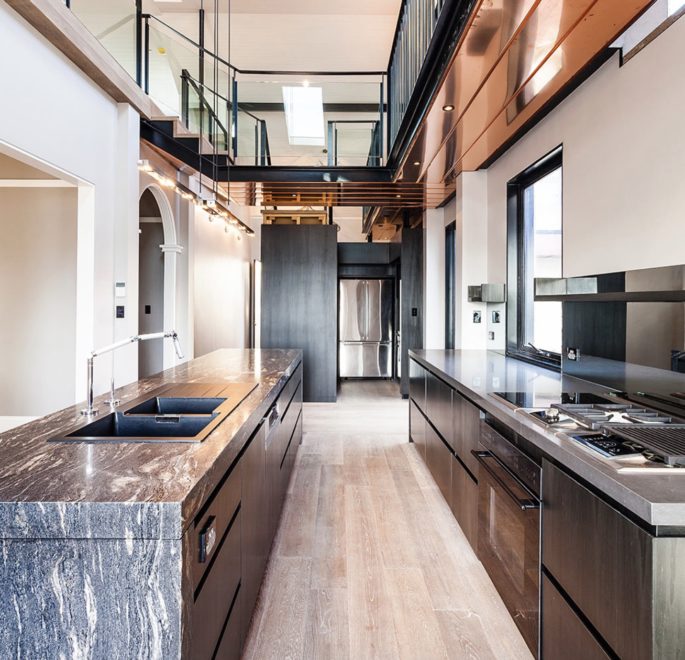
Ballast Point House European Oak Tongue and Groove Engineered Hardwood Flooring in Eterno – Classic Wire Brushed Texture, Oslo colour, www.tngflooring.com.au
SHOULD I CONSIDER USING RECLAIMED WOOD?
Absolutely. The charm of a reclaimed wood floor is hard to define and impossible to replicate. Wood flooring that has been crafted from reclaimed flooring whether engineered or solid, not only gives the timber a new lease of life, but also prevents the need for more trees to be harvested, so has the lowest environmental impact of any flooring. Reclaimed wood floors are extremely versatile style-wise, and the aesthetic depends on your preference: a reclaimed wood floor could be bleached, ebonized, or given a natural look.
If your floors will be subjected to high traffic (such as kids and dogs), you’re less likely to stress out when they’re reclaimed wood: you know your floor won’t stay perfect – it may even improve the patina.
At the other end of the spectrum, parquetry and chevron or herringbone-patterned styles are being used to add a sophisticated touch.
WHAT ARE THE OPTIONS FOR FIXING WOODEN FLOORING TOGETHER?
Tongue-and-groove is the most traditional type of floor fixing. The tongue (a protruding edge) fits into a perfectly sized gap (the groove) to allow two planks to slot together. It is secret nailed, secret screwed (the nail or screw goes through the tongue and is not visible from the surface), glued directly onto the subfloor, or can be floated over an underlay. Modern click-fit wooden boards, where two planks fit together audibly ‘click’ into place, are easier and quicker to install but are not suitable for solid wood flooring.
HOW ARE INTRICATE PARQUET FLOORS LAID?
From the middle of the floor, working outwards. The most popular patterns are herringbone, brick bond, and diagonal basket weave. Your chosen pattern does not affect the installation method. It is important to leave a gap of around 12mm around the edge of the room (which will be covered by skirting) so that the parquet can expand if necessary.
WHAT ARE THE REQUIREMENTS FOR LAYING A WOOD FLOOR?
You should have a subfloor that is flat, clean, and dry. Wood expands and contracts as humidity and temperature vary. If you need a stable floor, then you may want to consider an engineered floor.
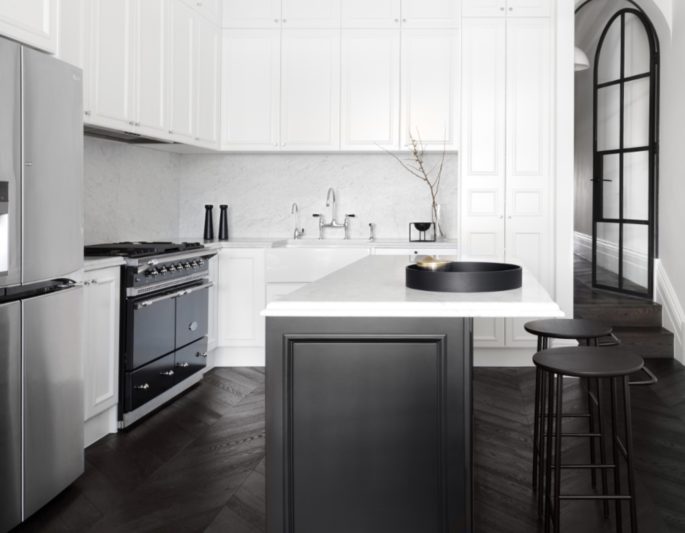
Prahran Residence, Tongue and Groove Engineered Hardwood Flooring, European Oak, Parquetry Chevron, in Penza colour, www.tngflooring.com.au
WHAT ABOUT FINISHES?
Before choosing a finish for your wood, think about the look you are trying to achieve, the environment the floor will be used in and the amount of maintenance you are prepared to take on. For high traffic areas, go for a lacquered finish, which requires virtually no maintenance. The drawback is that scratches are hard to mask and the floor will typically require a full sanding after about seven to ten years.
Scratches on oiled floors are easier to maintain by applying a new coat every year or so.
Also consider colour. The spectrum of shades you can achieve with traditional oils is limited, especially when clients are looking for different modern tones, such as grey. In theory, any colour can be achieved with a varnish or lacquer. The stain provides the colour and the finish goes on top of the stain to protect it and the wood. Designers often put a thick layer of stain on a wood floor to give it uniformity, but most floors that are uniform in colour are going to be compromised in longevity.
ANY OTHER OPTIONS?
As well as lacquer and oils, unfinished wood can go through various processes such as brushing – where the planks are roller brushed during the manufacturing process to create a textured surface that highlights the grain – and distressing, which adds extra marks so the wood appears older than it is. We’ve noticed a lot more greyish brown wood floors popping up in the world’s best houses because of Restoration Hardware over the past few years.

Woollahra House, Tongue and Groove Engineered Hardwood Flooring, European Oak, Eterno – Classic Wire Brushed Texture in Graupa colour, www.tngflooring.com.au
WHAT COLOURS ARE TRENDING NOW?
The most popular stains right now are a mid-chocolate and a grey-brown.
WHAT IS THERE TO CONSIDER WHEN IT COMES TO GRAIN?
It’s a matter of personal preference. If people want the floor to be a focal point, they need a more active grain. If they want the floor to blend into the background, they may opt for a calmer grain.
WHAT ARE THE MOST POPULAR WOODS?
Our casual research chatting to top suppliers suggests more than half of the wood flooring used in Australian interiors is oak. Maybe even two-thirds. Although there is a noticeable swing back towards Australian hardwoods such as spotted gum and blackbutt. After years of plain, featureless timbers, styles with natural imperfections such as knots and gum veins, are back in vogue.
YOU LIKE THE COLOUR OF YOUR FLOORS, BUT THE FINISH IS SCRATCHED AND WORN – WHAT’S THE SOLUTION?
A good buff, and repolish, or recoat. Buffing is a quick, relatively inexpensive method of shining wood floors, which involves lightly abrading the top coat of polyurethane, then applying a new coat of finish. This works best when the finish has been damaged, but the wood hasn’t. It’s a fast way to revive a floor that is in decent condition. An average size living room floor typically takes a day. A mid-chocolate or grey colour will make your floors and rooms look current – it’s not too heavy, it’s not too pale, and it’s not too Scandi.
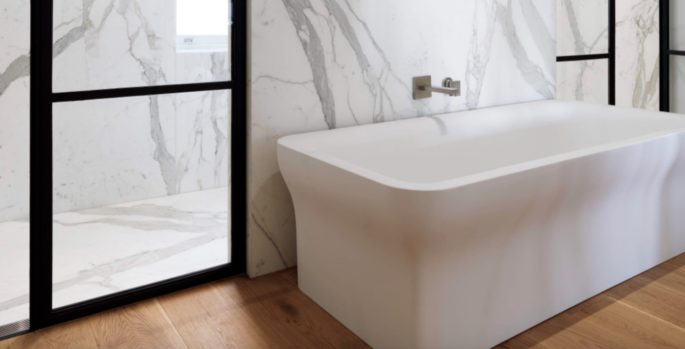
Woollahra House, Tongue and Groove Engineered Hardwood Flooring, European Oak, Eterno – Classic Wire Brushed Texture in Graupa colour, www.tngflooring.com.au
BEST FOR RECLAIMED WOOD:
PRECISION FLOORING
Where everyone goes for the best timber floor, made from European and American oaks and recycled timbers. Thomas Hamel, Iain Halliday, Blainey North, Greg Natale, Nick Tobias, Colette Dinnigan, James Packer, Lynda Kerry, are all repeat clients. Beautiful showroom with lots of giant displays to inspire. www.precisionflooring.com.au
BEST FOR ENGINEERED:
TONGUE N GROOVE
Choose from three layers of high quality, solid European oak, using state-of-the-art, engineering methods. They work with all the big name Australian architects and designers.. Available in three designs: Eterno (classic), Parquet (traditional) or Vecchio (rustic) each in two sizes, Grande or Piccolo. Up to 360m in widths and up to 5m in length, Everything is supplied, fitted and installed. www.tngflooring.com.au
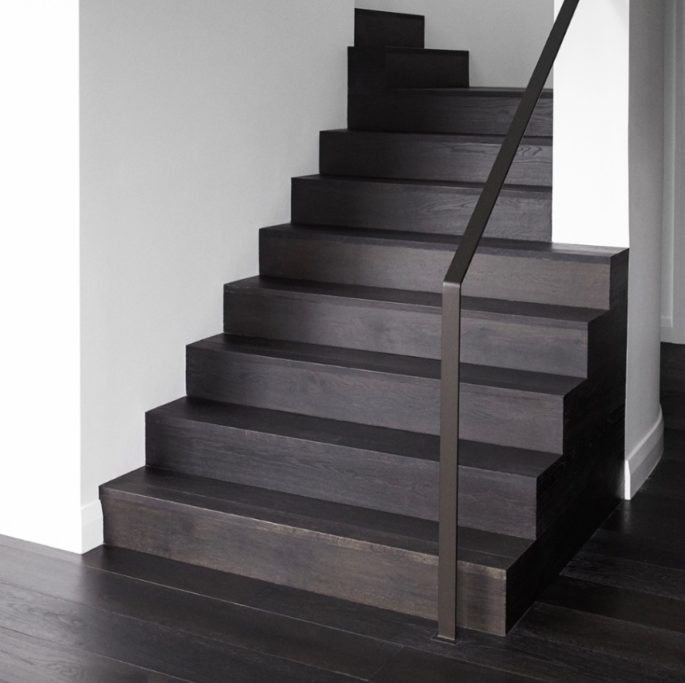
Sydney CBD Penthouse, Tongue and Groove Engineered Hardwood Flooring, Piccolo – 15mm Thick Solid Oak Construction, European Oak, Eterno – Classic Wire Brushed Texture, Raba colour, www.tngflooring.com.au
ROYAL OAK FLOORS
The Architect Collection of wide board engineered European Oak timber flooring are available in a variety of natural-lookingcolours in five size – all pre-finished, and tongue-and-grooved on sthe ends and sides. And graded ABCD, which means some boards will be clean and others will have knots. Read more in our Directory, ‘The Best Floor Cleaners & Repairs.’ The dimensions of the timber floorboard will determine the price per square metre, rather than your colour selection. A patterned chevron flooring features on a layer of European oak on an engineered base for improved stability. It comes in panel form so you can install it with minimal time and fuss. www.royaloakfloors.com.au
HURFORD FLOORING
The 80 year old Brisbane business, specialises in Boutique French oak pre-finished flooring range, plus elegant oak traditional tongue-and-groove engineered, replica timber planks, Australian native pre-finished range and replica timber planks. www.hurfordflooring.com.au

The QT Museum Hotel with European Oak Tongue and Groove Engineered Hardwood Flooring in the style of Eterno – Classic Wire Brushed Texture, Penza colour, tngflooring.com.au
BEST FOR HARD WAX OIL FINISHES:
BEST FOR PARQUET: WOODSTOCK RESOURCES
Supplies oak flooring with a rustic look, specialising in European products from re-milled French oak boards and parquetry to antique oak boards and Versailles panels, plus Dutch Hakwood pre-finished oak floorin. It wire brush boards to create a great patina that you can see at Suzie Anderson Home’s flagship showroom in Australia’s Southern Highlands. People like a worn look, that harkens back to things hand-made. We wire brush boards if required to create a great patina and texture with a sense of permanence. Our reclaimed wood, and antique boards remain hugely popular. We do flooring from 180mm to 240mm which is quite wide. The wider it is, the more expensive. But our most popular width is definitely 180mm. woodstockresources.com.au
BEST FOR LAMINATES:
QUICK STEP
Quality laminate planks that give you the look of timber without the maintenance, that are easy to install and waterproof, making them great option for kitchens, bathroom and laundries. Seek out ‘Impressive Ultra’ laminate planks in White Varnished Oak, $62/m² (supply only) well as laminate planks in Shale Grey, $39/m2. Quickstep.com.au
CARPET COURT
HONOURABLE MENTION TO SYDNEY FLOORING
In business for more than 50 years, this company offers a range of handcrafted Australian hardwoods from pale ashes to dark blackbutts, with everything from tongue-an-groove or herringbone parquetry. All work is guaranteed. Go for Tasmanian Oak and Spotted Gum which has attractive markings. www.sydneyflooring.com.au

